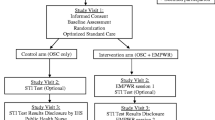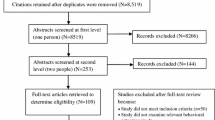Abstract
The purpose of this study was to evaluate the separate and combined effectiveness of brief and intensive interventions for sexual risk reduction among patients at a sexually transmitted disease (STD) clinic. Patients (N =1483; 54% men; 64% African-American; M = 29.2 years old) were recruited from a publicly funded, walk-in STD clinic. Patients completed a baseline assessment, and then were randomized to one of six intervention arms; each arm combined a brief intervention with an intensive intervention. The interventions provided different levels of information, motivational counseling, and behavioral skills training, guided by theory, formative research, and empiric precedent. Follow-up assessments, including STD screening, occurred at 3, 6, and 12 months post-intervention. The results showed that infection rates declined from 18.1% at baseline to 4.5% at 12 months. At a 3-month follow-up, patients reported fewer sexual partners, fewer episodes of unprotected sex, and a lower percentage of unprotected sexual events; they strengthened sexual health knowledge, safer sex attitudes and intentions, and self-efficacy beliefs. No consistent pattern of differential risk reduction was observed among the six intervention conditions, nor was any evidence of decay from 3 to 12-month follow-ups obtained. We conclude that implementing behavioral interventions in a STD clinic was associated with significant reduction of sexual risk behavior and risk antecedents.



Similar content being viewed by others
References
World Health Organization. Global prevalence and incidence of selected curable sexually transmitted infections: overview and estimates. 2001.
Centers for Disease Control and Prevention. 2006 disease profile. Atlanta, GA: National Center for HIV/AIDS, Viral Hepatitis, STD, and TB Prevention; 2008.
Weinstock H, Berman S, Cates W. Sexually transmitted diseases among American youth: incidence and prevalence estimates, 2000. Perspect Sex Reprod Health. 2004;36:6–10.
Hall HI, Song R, Rhodes P, et al. Estimation of HIV incidence in the United States. JAMA. 2008;300:520–9.
Centers for Disease Control and Prevention. Subpopulation estimates from the HIV Incidence Surveillance System—United States, 2006. MMWR. 2008;57:985–9.
Centers for Disease Control and Prevention. Trends in reportable sexually transmitted diseases in the United States, 2006. 2007.
D’Souza G, Kreimer AR, Viscidi R, et al. Case-control study of human papillomavirus and oropharyngeal cancer. N Engl J Med. 2007;356:1944–56.
Centers for Disease Control and Prevention. The role of STD prevention and treatment in HIV prevention. 2007.
Fleming DT, Wasserheit JN. From epidemiological synergy to public health policy and practice: the contribution of other sexually transmitted diseases to sexual transmission of HIV infection. Sex Transm Infect. 1999;75:3–17.
Howards PP, Thomas JC, Earp JA. Do clinic-based STD data reflect community patterns? Int J STD AIDS. 2002;13:775–80.
O’Donnell L, San Doval A, Vornfett R, O’Donnell CR. STD prevention and the challenge of gender and cultural diversity: knowledge, attitudes, and risk behaviors among black and Hispanic inner-city STD clinic patients. Sex Transm Dis. 1994;21:137–48.
Adimora AA, Schoenbach VJ, Doherty IA. Concurrent sexual partnerships among men in the United States. Am J Public Health. 2007;97:2230–7.
Adimora AA, Schoenbach VJ, Martinson FE, Donaldson KH, Fullilove RE, Aral SO. Social context of sexual relationships among rural African Americans. Sex Transm Dis. 2001;28:69–76.
Weinstock H, Sweeney S, Satten GA, Gwinn M. HIV seroincidence and risk factors among patients repeatedly tested for HIV attending sexually transmitted disease clinics in the United States, 1991 to 1996. J Acquir Immune Defic Syndr Hum Retrovirol. 1998;19:506–12.
Kamb ML, Fishbein M, Douglas JM Jr, et al. Efficacy of risk-reduction counseling to prevent human immunodeficiency virus and sexually transmitted diseases: a randomized controlled trial. Project RESPECT Study Group. JAMA. 1998;280:1161–7.
Fisher JD, Fisher WA. Theoretical approaches to individual-level change in HIV risk behavior. In: Peterson JL, DiClemente RJ, editors. Handbook of HIV prevention. New York: Kluwer Academic/Plenum; 2000. p. 3–55.
Copenhaver MM, Johnson BT, Lee IC, Harman JJ, Carey MP. Behavioral HIV risk reduction among people who inject drugs: meta-analytic evidence of efficacy. J Subst Abuse Treat. 2006;31:163–71.
Johnson BT, Carey MP, Chaudoir SR, Reid AE. Sexual risk reduction for persons living with HIV: research synthesis of randomized controlled trials, 1993 to 2004. J Acquir Immune Defic Syndr. 2006;41:642–50.
Smoak ND, Scott-Sheldon LA, Johnson BT, Carey MP. Sexual risk reduction interventions do not inadvertently increase the overall frequency of sexual behavior: a meta-analysis of 174 studies with 116,735 participants. J Acquir Immune Defic Syndr. 2006;41:374–84.
Kelly JA. Changing HIV risk behavior: practical strategies. New York: Guilford; 1995.
Kalichman SC. Preventing AIDS: a sourcebook for behavioral interventions. Mahway: Lawrence Erlbaum Associates, Publishers; 1998.
Dunn C, Deroo L, Rivara FP. The use of brief interventions adapted from motivational interviewing across behavioral domains: a systematic review. Addiction. 2001;96:1725–42.
Kalichman SC, Carey MP, Johnson BT. Prevention of sexually transmitted HIV infection: a meta-analytic review of the behavioral outcome literature. Ann Behav Med. 1996;18:6–15.
Carey MP, Vanable PA, Senn TE, Coury-Doniger P, Urban MA. Evaluating a two-step approach to sexual risk reduction in a publicly-funded STI clinic: rationale, design, and baseline data from the Health Improvement Project-Rochester (HIP-R). Contemp Clin Trials. 2008;29:569–86.
Schroder KE, Carey MP, Vanable PA. Methodological challenges in research on sexual risk behavior: II. accuracy of self-reports. Ann Behav Med. 2003;26:104–23.
Coury-Doniger P, Levenkron JC, Knox KL, Cowell S, Urban MA. Use of stage of change (SOC) to develop an STD/HIV behavioral intervention: phase 1. A system to classify SOC for STD/HIV sexual risk behaviors—development and reliability in an STD clinic. AIDS Patient Care STDS. 1999;13:493–502.
Prochaska JO, DiClemente CC, Norcross JC. In search of how people change: applications to addictive behaviors. Am Psychol. 1992;47:1102–14.
Apanovitch AM, McCarthy D, Salovey P. Using message framing to motivate HIV testing among low-income, ethnic minority women. Health Psychol. 2003;22:60–7.
Fisher JD, Fisher WA. Changing AIDS-risk behavior. Psychol Bull. 1992;111:455–74.
Center for AIDS Intervention Research. Partners in prevention (intervention manual). 2007. http://www.mcw.edu/display/docid6269/PartnersinPrevention.htm. Accessed 25 June 2009.
Carey MP, Braaten LS, Maisto SA, Gleason JR, Forsyth AD, Durant LE. Using information, motivational enhancement, and skills training to reduce the risk of HIV infection for low-income urban women: a second randomized clinical trial. Health Psychol. 2000;19:3–11.
Carey MP, Carey KB, Maisto SA, Gordon CM, Schroder KE, Vanable PA. Reducing HIV-risk behavior among adults receiving outpatient psychiatric treatment: results from a randomized controlled trial. J Consult Clin Psychol. 2004;72:252–68.
Carey MP, Maisto SA, Kalichman SC, Forsyth AD, Wright EM, Johnson BT. Enhancing motivation to reduce the risk of HIV infection for economically disadvantaged urban women. J Consult Clin Psychol. 1997;65:531–41.
NIMH Multisite HIV Prevention Trial Group. The NIMH multisite HIV prevention trial: reducing HIV sexual risk behavior. Science. 1998;280:1889–94.
Van Der Pol B, Ferrero DV, Buck-Barrington L, et al. Multicenter evaluation of the BDProbeTec ET System for detection of Chlamydia trachomatis and Neisseria gonorrhoeae in urine specimens, female endocervical swabs, and male urethral swabs. J Clin Microbiol. 2001;39:1008–16.
Carey MP, Schroder KE. Development and psychometric evaluation of the brief HIV Knowledge Questionnaire. AIDS Educ Prev. 2002;14:172–82.
Jaworski BC, Carey MP. Development and psychometric evaluation of a self-administered questionnaire to measure knowledge of sexually transmitted diseases. AIDS Behav. 2007;11:557–74.
Brown IS. Development of a scale to measure attitude toward the condom as a method on birth control. J Sex Res. 1984;20:255–63.
Sacco WP, Levine B, Reed DL, Thompson K. Attitudes about condom use as an AIDS-relevant behavior: their factor structure and relation to condom use. Psychol Assess. 1991;3:265–72.
Noar SM, Morokoff PJ, Harlow LL. Condom influence strategies in a community sample of ethnically diverse men and women. J Appl Soc Psychol. 2004;38:1730–51.
Murphy DA, Stein JA, Schlenger W, Mailbach E. Conceptualizing the multidimensional nature of self-efficacy: assessment of situational context and level of behavioral challenges to maintain safer sex. Health Psychol. 2001;20:281–90.
HLM 6: Hierarchical linear and nonlinear modeling [computer software]. Scientific Software International, Inc. 2004.
Diggle P, Heagerty P, Liang K-Y, Zeger S. Analysis of longitudinal data. Oxford, England: Oxford University Press; 2005.
Carey MP, Senn TE, Vanable PA, Coury-Doniger P, Urban MA. Do STD clinic patients who consent to sexual health research differ from those who decline? Findings from a randomized controlled trial with implications for the generalization of research results. Sex Transm Dis. 2008;35:73–7.
Senn TE, Carey MP, Vanable PA, Coury-Doniger P, Urban M. Even if you build it, we may not come: correlates of non-attendance at a sexual risk reduction workshop for STD clinic patients. AIDS Behav. 2007;11:864–71.
Fishbein M, Pequegnat W. Evaluating AIDS prevention interventions using behavioral and biological outcome measures. Sex Transm Dis. 2000;27:101–10.
Crepaz N, Horn AK, Rama SM, et al. The efficacy of behavioral interventions in reducing HIV risk sex behaviors and incident sexually transmitted disease in black and Hispanic sexually transmitted disease clinic patients in the United States: a meta-analytic review. Sex Transm Dis. 2007;34:319–32.
Darbes L, Crepaz N, Lyles C, Kennedy G, Rutherford G. The efficacy of behavioral interventions in reducing HIV risk behaviors and incident sexually transmitted diseases in heterosexual African Americans. AIDS. 2008;22:1177–94.
Krauss BJ, Goldsamt L, Bula E, Godfrey C, Yee DS, Palij M. Pretest assessment as a component of safer sex intervention: a pilot study of brief one-session interventions for women partners of male injection drug users in New York City. J Urban Health. 2000;77:383–95.
O’Leary A, Ambrose TK, Raffaelli M, et al. Effects of an HIV risk reduction project on sexual risk behavior of low-income STD patients. AIDS Educ Prev. 1998;10:483–92.
Purcell DW, Latka MH, Metsch LR, et al. Results from a randomized controlled trial of a peer-mentoring intervention to reduce HIV transmission and increase access to care and adherence to HIV medications among HIV-seropositive injection drug users. J Acquir Immune Defic Syndr. 2007;46:S35–47.
Ostrow DG, Kalichman SC. Methodological issues in HIV behavioral interventions. In: Peterson JL, DiClemente RJ, editors. Handbook of HIV prevention. New York: Kluwer Academic/Plenum; 2000. p. 67–80.
Butryn ML, Phelan S, Hill JO, Wing RR. Consistent self-monitoring of weight: a key component of successful weight loss maintenance. Obesity. 2007;15:3091–6.
Sanchez-Craig M, Davila R, Cooper G. A self-help approach for high-risk drinking: effect of an initial assessment. J Consul Clin Psychol. 1996;64:694–700.
van Sluijs EMF, van Poppel MNM, Rwisk JWR, van Mechelen W. Physical activity measurements affected participants' behavior in a randomized controlled trial. J Clin Epid. 2006;59:404–11.
Des Jarlais DC, Paone D, Milliken J, et al. Audio-computer interviewing to measure risk behavior for HIV among injecting drug users: a quasi-randomized trial. Lancet. 1999;353:1657–71.
Metzger DS, Koblin B, Turner CF, et al. Randomized controlled trial of audio computer-assisted self-interviewing: utility and acceptability in longitudinal studies. Am J Epidemiol. 2000;152:99–106.
Lightfoot M, Rotheram-Borus MJ, Comulada S, Gundersen G, Reddy V. Self-monitoring of behaviour as a risk reduction strategy for persons living with HIV. AIDS Care. 2007;19:757–63.
Weinhardt LS, Carey KB, Carey MP. HIV risk sensitization following a detailed sexual behavior interview: a preliminary investigation. J Behav Med. 2000;23:393–8.
Campbell DT, Stanley JC. Experimental and quasi-experimental designs for research. Boston: Houghton Mifflin Company; 1963.
Potterat JJ, Zimmerman-Rogers H, Muth SQ, et al. Chlamydia transmission: concurrency, reproduction number, and the epidemic trajectory. Am J Epidemiol. 1999;150:1331–9.
Watts CH, May RM. The influence of concurrent partnerships on the dynamics of HIV/AIDS. Math Biosci. 1992;108:89–104.
Whitehead TL. Urban low-income African American men, HIV/AIDS, and gender identity. Med Anthropol Q. 1997;11:411–47.
Eng TR, Butler WT, editors. The hidden epidemic: confronting sexually transmitted diseases. Washington, DC: National Academy Press; 1997.
St. Lawrence JS, Fortenberry JD. Behavioral interventions for STDs: theoretical models and intervention methods. In: Aral SO, Douglas JM, Lipshutz JA, editors. Behavioral interventions for prevention and control of sexually transmitted diseases. New York: Springer; 2007. p. 23–59.
Acknowledgments
This study was supported by grant R01MH068171 from the Center for Mental Health Research on AIDS, National Institute of Mental Health to Michael P. Carey.
Author information
Authors and Affiliations
Corresponding author
Rights and permissions
About this article
Cite this article
Carey, M.P., Senn, T.E., Vanable, P.A. et al. Brief and Intensive Behavioral Interventions to Promote Sexual Risk Reduction among STD Clinic Patients: Results from a Randomized Controlled Trial. AIDS Behav 14, 504–517 (2010). https://doi.org/10.1007/s10461-009-9587-1
Received:
Accepted:
Published:
Issue Date:
DOI: https://doi.org/10.1007/s10461-009-9587-1




